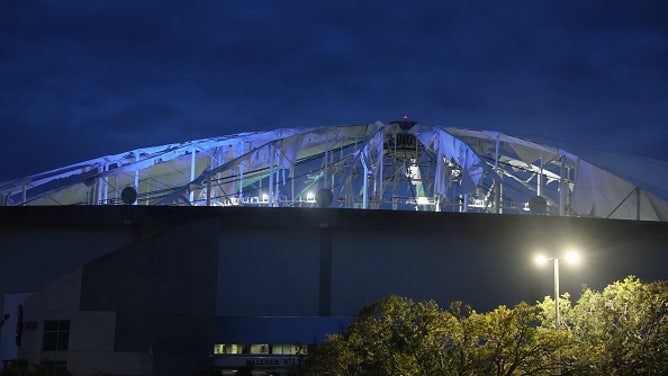We support our Publishers and Content Creators. You can view this story on their website by CLICKING HERE.
The Tampa Bay Rays are facing some very difficult questions heading into the 2024-25 Major League Baseball offseason. Yes, they do have work to do on their on-field roster after missing the playoffs for the first time since 2018. And yes, what used to be their biggest star and presumed long-term shortstop just got arrested again.
READ: Scorned MLB Player Arrested For Gun-Related Scene
But the biggest question mark is where in the world they’ll play their games after Hurricane Milton literally tore the roof off their home stadium. With the start of the 2025 regular season somehow just over four months away, we might have a bit more of an answer.
According to the Tampa Bay Times, the cost to repair the roof would be nearly $56 million, and with the Rays set to move into a new stadium for the 2028 season anyway, the city might not be willing to foot the bill. And there are more hurdles: there would need to be further exams to ensure that the electrical systems and other internal components don’t need repairing.
Still, if the city signs off, construction would be completed in time for the 2026 season. But where do they go for 2025?

ST. PETERSBURG, FLORIDA – OCTOBER 10: The roof at Tropicana Field, the home of the Tampa Bay Rays, sustained major damage because of high winds associated with Hurricane Milton on October 10, 2024 in St. Petersburg, Florida. Milton, which comes just after the recent catastrophic Hurricane Helene, landed into Florida’s Gulf Coast late Wednesday evening as a Category 3 storm causing extensive flooding and damage. (Photo by Spencer Platt/Getty Images)
Tampa Bay Rays To Become Second Team To Play At Small Stadium
Major League Baseball in 2025 is going to look very different. The Athletics, the team formerly known as the Oakland A’s, are going to play in a minor league stadium near Sacramento for 2025. And with Commissioner Rob Manfred saying he wants the Rays to remain in the Tampa area, it seems the team is down to just two options for its 2025 home.
Per the Tampa Bay Times, those options are the Phillies’ spring training facility, BayCare Ballpark in Clearwater, and Steinbrenner Field in Tampa, where the Yankees play their spring training games.
So we’re likely to have not one, but two teams playing their home games at stadiums that host minor league games. Not ideal for the league.
The Rays have never had particularly high attendance figures, so a spring training facility might actually lead to more sellouts than they’d have in a normal year. The novelty of seeing competitive, meaningful games at such a small, intimate venue could provide an attendance boost. Though the summer heat in Florida at an outdoor stadium could counteract that somewhat.
Unfortunately, they don’t seem to have much choice. And if the city declines to invest tens of millions into a stadium that won’t be used by 2028, it might be a much longer term solution than they’d like.

 Conservative
Conservative  Search
Search Trending
Trending Current News
Current News 





